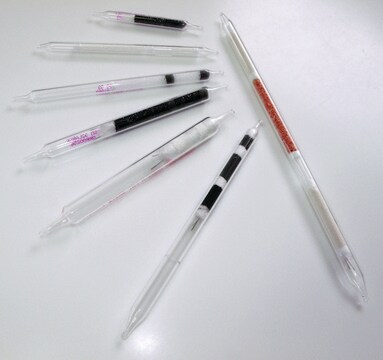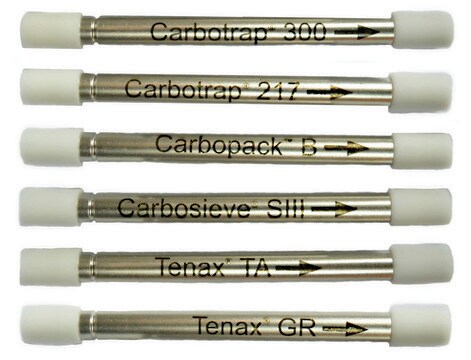推薦產品
產品名稱
Carbosieve SIII, stainless steel TD tube, O.D. × I.D. × L 6 mm × 4 mm × 7 in., preconditioned, pkg of 1 ea
材料
stainless steel TD tube
品質等級
agency
EPA TO-2
描述
Sealed with TDS³ Storage Container
產品線
Carbosieve
特點
preconditioned
包裝
pkg of 1 ea
環保替代產品特色
Waste Prevention
Safer Solvents and Auxiliaries
Learn more about the Principles of Green Chemistry.
sustainability
Greener Alternative Product
技術
active air sampling: suitable
外徑 × 內徑 × 長度
6 mm × 4 mm × 7 in.
基質
Carbosieve S-III carbon molecular sieve (CMS)
應用
air monitoring
environmental
industrial hygiene
相容性
for use with Gerstel® TDS A & TDS 2
環保替代類別
尋找類似的產品? 前往 產品比較指南
一般說明
Carbosieve SIII is a prepacked stainless steel sampling tube, fully compatible with the Gerstel TDS and TDSA instruments. It is thermally conditioned and batch tested for backpressure and background.
We are committed to bringing you greener alternative products, which adhere to one or more of The 12 Principles of Greener Chemistry. Thermal desorption tubes are reusable at least 50 to 100 times, and reduces the usage of accessories like transfer vials, caps, and pipette tips, thus aligns with “Waste Prevention”. Also, these tubes eliminate the usage of toxic solvents like CS2 to extract the VOCs of interest, and thus aligns with “Safer Solvents and Auxiliaries” principle. Click here for more information.
法律資訊
GERSTEL is a registered trademark of Gerstel GmbH & Co. KG
儲存類別代碼
11 - Combustible Solids
閃點(°F)
Not applicable
閃點(°C)
Not applicable
C Y Peng et al.
Journal of environmental monitoring : JEM, 2(4), 313-324 (2001-03-16)
Air sampling, using sorbents, thermal desorption and gas chromatography, is a versatile method for identifying and quantifying trace levels of volatile organic compounds (VOCs). Thermal desorption can provide high sensitivity, appropropriate choices of sorbents and method parameters can accommodate a
Juliane Hollender et al.
Journal of chromatography. A, 962(1-2), 175-181 (2002-08-30)
A simple method using active trapping on adsorbents and thermal desorption followed by GC-MS analysis was developed for the indoor air monitoring of monoterpenes. The study was carried out using a dynamically generated atmosphere consisting of 11 monoterpenes: camphene, camphor
D R Nelson et al.
Applied microbiology, 28(2), 258-261 (1974-08-01)
A gas chromatographic procedure for the simultaneous analysis of (14)C-labeled and unlabeled metabolic gases from microbial methanogenic systems is described. H(2), CH(4), and CO(2) were separated within 2.5 min on a Carbosieve B column and were detected by thermal conductivity.
Stuart Batterman et al.
Journal of environmental monitoring : JEM, 4(3), 361-370 (2002-07-04)
While air sampling techniques using adsorbent-based collection, thermal desorption and chromatographic analysis have found a niche in ambient air sampling, occupational applications have been more limited. This paper evaluates the use of thermal desorption techniques for low flow active and
Yannick Juillet et al.
The Analyst, 130(6), 977-982 (2005-05-25)
Among the chemicals belonging to the schedules of the Chemical Weapons Convention (CWC), sampling and analysis of highly volatile compounds such as hydrogen cyanide (HCN) require special consideration. The latter is present in numerous old chemical weapons that are stockpiled
我們的科學家團隊在所有研究領域都有豐富的經驗,包括生命科學、材料科學、化學合成、色譜、分析等.
聯絡技術服務








